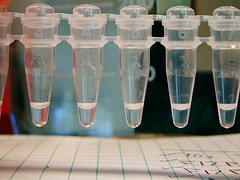You are at the airport burning away time with a report due tomorrow morning for your professor. You have your data. Why not take advantage of the time and calculate the expression fold change for the genes you have tested in that first qPCR experiment you did last week?
It’s easy – I’ll show you how.
Check Your Method
There are two main ways to analyze qPCR data: double delta Ct analysis and the relative standard curve method (Pfaffl method). Both methods make assumptions and have their limitations, so the method you should use for your analysis will depend on your experimental design.
The double delta Ct analysis assumes that:
- there is equal primer efficiency between primer sets (i.e. within 5%);
- there is near 100% amplification efficacy of the reference and the target genes;
- the internal control genes are constantly expressed and aren’t affected by the treatment.
The method generally caters to experiments with a large number of DNA samples and a low number of genes to be tested.
The relative standard curve method assumes that:
- there are equal efficiencies between the control and the treated samples.
This method works better if you have fewer DNA samples but a larger number of genes to test.
What You Need for Double Delta Ct Analysis
- qPCR Ct values (raw data) for:
- the housekeeping gene: control and experimental conditions;
- the gene of interest: control and experimental conditions;
- An Excel spreadsheet.
And that’s it! No expensive software required.
Here is a quick summary of the key steps in the double delta Ct analysis (for a detailed explanation read this paper).
4 Steps for Double Delta Ct Analysis
1. Take the average of the Ct values for the housekeeping gene and the gene being tested in the experimental and control conditions, returning 4 values. The 4 values are Gene being Tested Experimental (TE), Gene being Tested Control (TC), Housekeeping Gene Experimental (HE), and Housekeeping Gene Control (HC).
| Average Experimental Ct Value | Average Experimental Ct Value | Average Control Ct Value | Average Control Ct Value | \DeltaCt Value (Experimental) | ∆Ct Value (Control) |
|---|---|---|---|---|---|
| TE | HE | TC | HC | \DeltaCTE | \DeltaCTC |
| 21.27 | 20.23 | 19.60 | 19.27 | 1.03 | 0.33 |
2. Calculate the differences between experimental values (TE – HE) and the control values (TC – HC). These are your ΔCt values for the experimental (∆CTE) and control (∆CTC) conditions, respectively.
3. Then, calculate the difference between the \DeltaCT values for the experimental and the control conditions (\DeltaCTE – \DeltaCTC) to arrive at the double delta Ct value (\Delta\DeltaCt).
4. Since all calculations are in logarithm base 2, every time there is twice as much DNA, your Ct values decrease by 1 and will not halve. You need to calculate the value of 2^{-\Delta\Delta C_{t}} to get the expression fold change.
| \DeltaCt Value (Experimental) | \DeltaCt Value (Control) | \Delta\DeltaCt Value | Expression Fold Change |
|---|---|---|---|
| \DeltaCTE | \DeltaCTC | \Delta\DeltaCt | 2^{-\Delta\Delta C_{t}} |
| 1.03 | 0.33 | 0.70 | 0.615572207 |
What Does the Value Mean?
Now that you have your value for fold change, what does it actually mean? This value is the fold change of your gene of interest in the test condition, relative to the control condition, which has all been normalized to your housekeeping gene.
To make it a little clearer – you can think about it as a percentage. A fold change of 1 means that there is 100% as much gene expression in your test condition as in your control condition – so there is no change between the experimental group and the control group. A fold-change value above 1 is showing upregulation of the gene of interest relative to the control (1.2-fold change = 120% gene expression relative to control, 5 = 500%, 10 = 1,000%, etc.). Values below 1 are indicative of gene downregulation relative to the control (fold change of 0.5 is 50% gene expression relative to control, so half as much expression as in the control, etc.).
You can present these data as fold-change bar charts, graphing the control conditions equal to 1. You can also use statistical analyses to check the significance of the changes, e.g. using an analysis of variance (ANOVA) or t-tests, whatever is appropriate for your experimental set-up!
Using these steps you can conduct your qPCR analysis wherever you are, even if you’re on a road trip. To make things even easier, you can create an Excel template to use each time. Then you will only have to input your data and you will astonish others with your alacrity in conducting analyses!
Need more qPCR help? Discover our top 11 qPCR papers and improve your qPCR data and analysis.
Originally published July 9, 2016. Reviewed and updated on February 8, 2021.
Further Reading
Livak KJ, Schmittgen TD. Analysis of Relative Gene Expression Data Using RealTime Quantitative PCR and the 2^{-\Delta\Delta C_{t}} Method. Methods. 2001;25:402–8.







